Preparation of Novel Biodegradable Polymer Slow-Release Fertilizers to Improve Nutrient Release Performance and Soil Phosphorus Availability
Abstract
:1. Introduction
2. Materials and Methods
2.1. Materials
2.2. Methods
2.2.1. Preparation of Urea Phosphate
2.2.2. Preparation of PSNP
2.2.3. SEM Analysis
2.2.4. FTIR Analysis
2.2.5. XRD Analysis
2.2.6. Thermal Analysis
2.2.7. Slow-Release Performance in Soil
2.2.8. Effect on Soil Available P
2.2.9. Vertical Migration Effect of Soil Available P
2.2.10. Data Analyses
3. Results and Discussion
3.1. Synthesis Mechanism
3.2. Structural Characterization
3.2.1. SEM Analysis
3.2.2. FTIR Analysis
3.2.3. XRD Analysis
3.2.4. Thermal Analysis
3.3. Slow-Release Behavior of PSNP in Soil
3.4. Effect on Soil Available P Content
3.5. Vertical Migration Effect of Soil Available P
3.6. Mechanism of Improving P Utilization Efficiency
4. Conclusions
Author Contributions
Funding
Institutional Review Board Statement
Data Availability Statement
Conflicts of Interest
References
- Mardamootoo, T.; Du Preez, C.; Barnard, J. Phosphorus management issues for crop production: A review. Afr. J. Agric. Res. 2021, 17, 939–952. [Google Scholar]
- Bi, S.; Barinelli, V.; Sobkowicz, M.J. Degradable controlled release fertilizer composite prepared via extrusion: Fabrication, characterization, and release mechanisms. Polymers 2020, 12, 301. [Google Scholar]
- Logan, T.J. Agricultural best management practices for water pollution control: Current issues. Agric. Ecosyst. Environ. 1993, 46, 223–231. [Google Scholar]
- Bai, W.; Ji, B.; Fan, L.; Peng, Q.; Liu, Q.; Song, J. Preparation and Characterization of a Novel Cassava Starch-Based Phosphorus Releasing Super-Absorbent Polymer, and Optimization of the Performance of Water Absorption and Phosphorus Release. Polymers 2023, 15, 1233. [Google Scholar]
- Jindo, K.; Audette, Y.; Olivares, F.L.; Canellas, L.P.; Smith, D.S.; Paul Voroney, R. Biotic and abiotic effects of soil organic matter on the phytoavailable phosphorus in soils: A review. Chem. Biol. Technol. Agric. 2023, 10, 29. [Google Scholar]
- Yao, Y.; Gao, B.; Chen, J.; Yang, L. Engineered biochar reclaiming phosphate from aqueous solutions: Mechanisms and potential application as a slow-release fertilizer. Environ. Sci. Technol. 2013, 47, 8700–8708. [Google Scholar]
- Lu, H.; Tian, H.; Liu, Z.; Zhang, M.; Zhao, C.; Guo, Y.; Guan, R.; Chen, Q.; Yu, X.; Wang, H.; et al. Polyolefin Wax Modification Improved Characteristics of Nutrient Release from Biopolymer-Coated Phosphorus Fertilizers. ACS Omega 2019, 4, 20402–20409. [Google Scholar]
- Li, H.; Yang, L.; Cao, J.; Nie, C.; Liu, H.; Tian, J.; Chen, W.; Geng, P.; Xie, G. Water-preserving and salt-resistant slow-release fertilizers of polyacrylic acid-potassium humate coated ammonium dihydrogen phosphate. Polymers 2021, 13, 2844. [Google Scholar]
- Garcia, M.; Diez, J.; Vallejo, A.; Garcia, L.; Cartagena, M.C. Effect of applying soluble and coated phosphate fertilizers on phosphate availability in calcareous soils and on P absorption by a rye-grass crop. J. Agric. Food Chem. 1997, 45, 1931–1936. [Google Scholar]
- Diez, J.; Cartagena, M.; Vallejo, A. Controlling phosphorus fixation in calcareous soils by using coated diammonium phosphate. Fertil. Res. 1992, 31, 269–274. [Google Scholar]
- Ko, B.-S.; Cho, Y.-S.; Rhee, H.-K. Controlled release of urea from rosin-coated fertilizer particles. Ind. Eng. Chem. Res. 1996, 35, 250–257. [Google Scholar]
- Bernardo, M.P.; Guimarães, G.G.F.; Majaron, V.F.; Ribeiro, C. Controlled Release of Phosphate from Layered Double Hydroxide Structures: Dynamics in Soil and Application as Smart Fertilizer. ACS Sustain. Chem. Eng. 2018, 6, 5152–5161. [Google Scholar]
- Zhan, F.; Liu, M.; Guo, M.; Wu, L. Preparation of superabsorbent polymer with slow-release phosphate fertilizer. J. Appl. Polym. Sci. 2004, 92, 3417–3421. [Google Scholar]
- Pourjavadi, A.; Doulabi, M.; Soleyman, R.; Sharif, S.; Eghtesadi, S.A. Synthesis and characterization of a novel (salep phosphate)-based hydrogel as a carrier matrix for fertilizer release. React. Funct. Polym. 2012, 72, 667–672. [Google Scholar]
- Li, J.; Liu, Y.; Liu, J.; Cui, X.; Hou, T.; Cheng, D. A novel synthetic slow release fertilizer with low energy production for efficient nutrient management. Sci. Total Environ. 2022, 831, 154844–154855. [Google Scholar]
- Cheng, D.; Zhao, G.; Bai, T.; Liu, Y. Preparation and Nutrient Release Mechanism of a Polymer as Slow-Release Compound Fertilizer. J. Chem. Soc. Pak. 2014, 36, 647–653. [Google Scholar]
- Salthammer, T.; Gunschera, J. Release of formaldehyde and other organic compounds from nitrogen fertilizers. Chemosphere 2021, 263, 127913–127920. [Google Scholar]
- Xiang, Y.; Ru, X.; Shi, J.; Song, J.; Zhao, H.; Liu, Y.; Zhao, G. Granular, Slow-Release Fertilizer from Urea-formaldehyde, Ammonium Polyphosphate, and Amorphous Silica Gel: A New Strategy Using Cold Extrusion. J. Agric. Food Chem. 2018, 66, 7606–7615. [Google Scholar]
- Xie, L.; Liu, M.; Ni, B.; Wang, Y. Utilization of wheat straw for the preparation of coated controlled-release fertilizer with the function of water retention. J. Agric. Food Chem. 2012, 60, 6921–6928. [Google Scholar]
- Mikkelsen, R. Biuret in urea fertilizer. Fertil. Res. 1990, 26, 311–318. [Google Scholar]
- Sundera-Rao, R.; Turley, J.; Pepinsky, R. The crystal structure of urea phosphate. Acta Crystallogr. 1957, 10, 435–436. [Google Scholar]
- Giroto, A.S.; Guimarães, G.G.F.; Ribeiro, C. A Novel, Simple Route to Produce Urea:Urea–Formaldehyde Composites for Controlled Release of Fertilizers. J. Polym. Environ. 2017, 26, 2448–2458. [Google Scholar]
- Abou-Okeil, A.; El-Shafie, A. Urea phosphate/β-cyclodextrin inclusion complex to enhance thermal behavior of cotton fabric. Carbohydr. Polym. 2011, 84, 593–598. [Google Scholar]
- Xiang, Y.; Ru, X.; Shi, J.; Song, J.; Zhao, H.; Liu, Y.; Guo, D.; Lu, X. Preparation and Properties of a Novel Semi-IPN Slow-Release Fertilizer with the Function of Water Retention. J. Agric. Food Chem. 2017, 65, 10851–10858. [Google Scholar]
- Wibowo, E.S.; Park, B.-D.; Causin, V. Hydrogen-Bond-Induced Crystallization in Low-Molar-Ratio Urea–Formaldehyde Resins during Synthesis. Ind. Eng. Chem. Res. 2020, 59, 13095–13104. [Google Scholar]
- McCullough, J.F.; Sheridan, R.C.; Frederick, L.L. Pyrolysis of urea phosphate. J. Agric. Food Chem. 1978, 26, 670–675. [Google Scholar]
- Shao, Z.-B.; Deng, C.; Tan, Y.; Yu, L.; Chen, M.-J.; Chen, L.; Wang, Y.-Z. Ammonium polyphosphate chemically-modified with ethanolamine as an efficient intumescent flame retardant for polypropylene. J. Mater. Chem. A 2014, 2, 13955–13965. [Google Scholar]
- Cherrat, A.; Bettach, M.; Ennaciri, Y.; El Alaoui-Belghiti, H.; Benkhouja, K. Wet synthesis of high purity crystalline urea phosphate from untreated Moroccan industrial phosphoric acid. Moroc. J. Chem. 2020, 8, 1024–1032. [Google Scholar]
- Xiang, Y.; Li, C.; Hao, H.; Tong, Y.; Chen, W.; Zhao, G.; Liu, Y. Performances of biodegradable polymer composites with functions of nutrient slow-release and water retention in simulating heavy metal contaminated soil: Biodegradability and nutrient release characteristics. J. Clean. Prod. 2021, 294, 126278–126292. [Google Scholar]
- Tian, H.; Qiao, J.; Zhu, Y.; Jia, X.; Shao, M. Vertical distribution of soil available phosphorus and soil available potassium in the critical zone on the Loess Plateau, China. Sci. Rep. 2021, 11, 3159–3168. [Google Scholar]
- An, T.; Qin, Y.; Cheng, H.; Wu, J.; Su, W.; Meng, G.; Wei, H.; Sun, C.; Liu, Z.; Guo, X. TiO2-WO3 activated weathered lignite coating phosphate fertilizer to improve longitudinal migration efficiency. J. Clean. Prod. 2022, 351, 131549–131561. [Google Scholar]


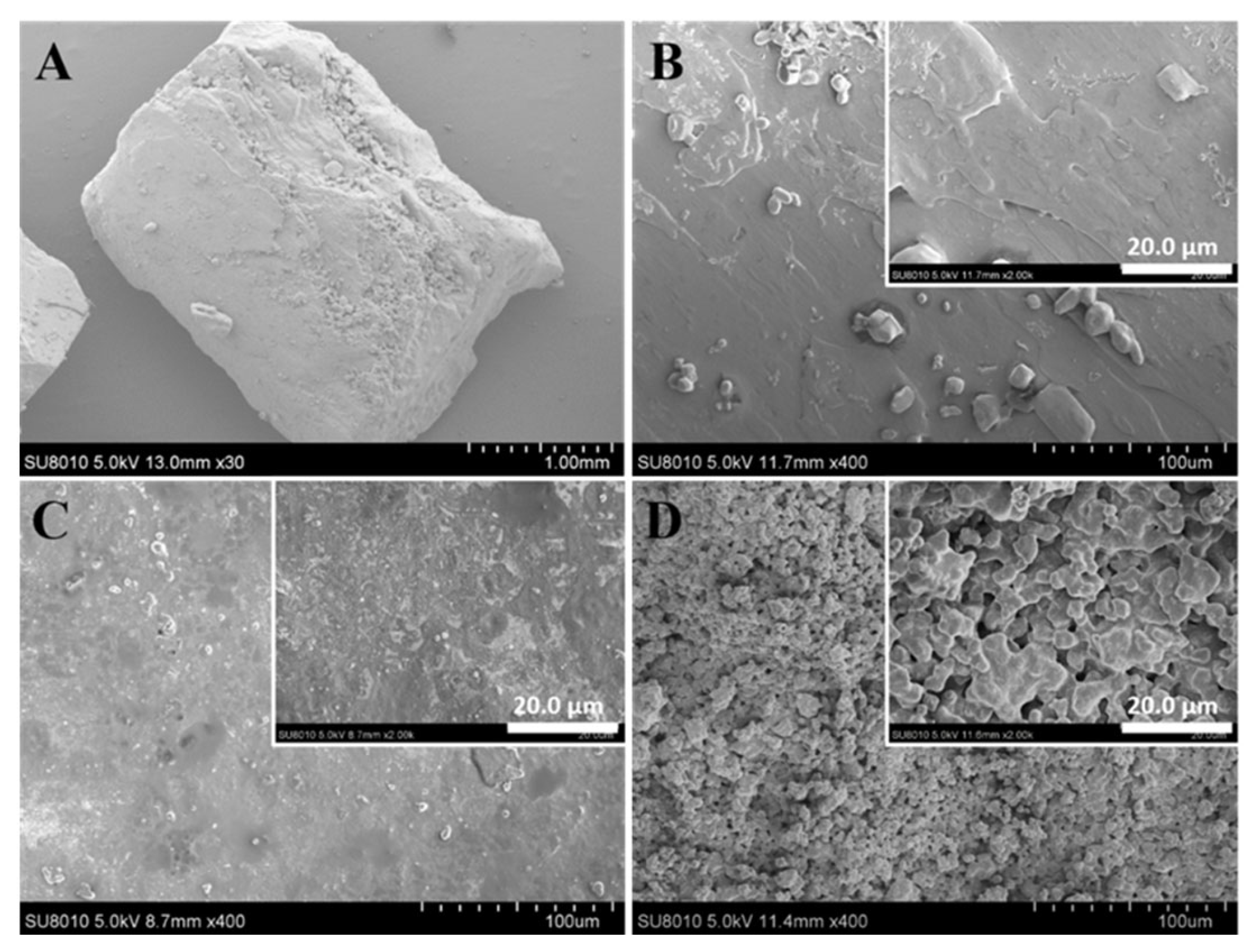
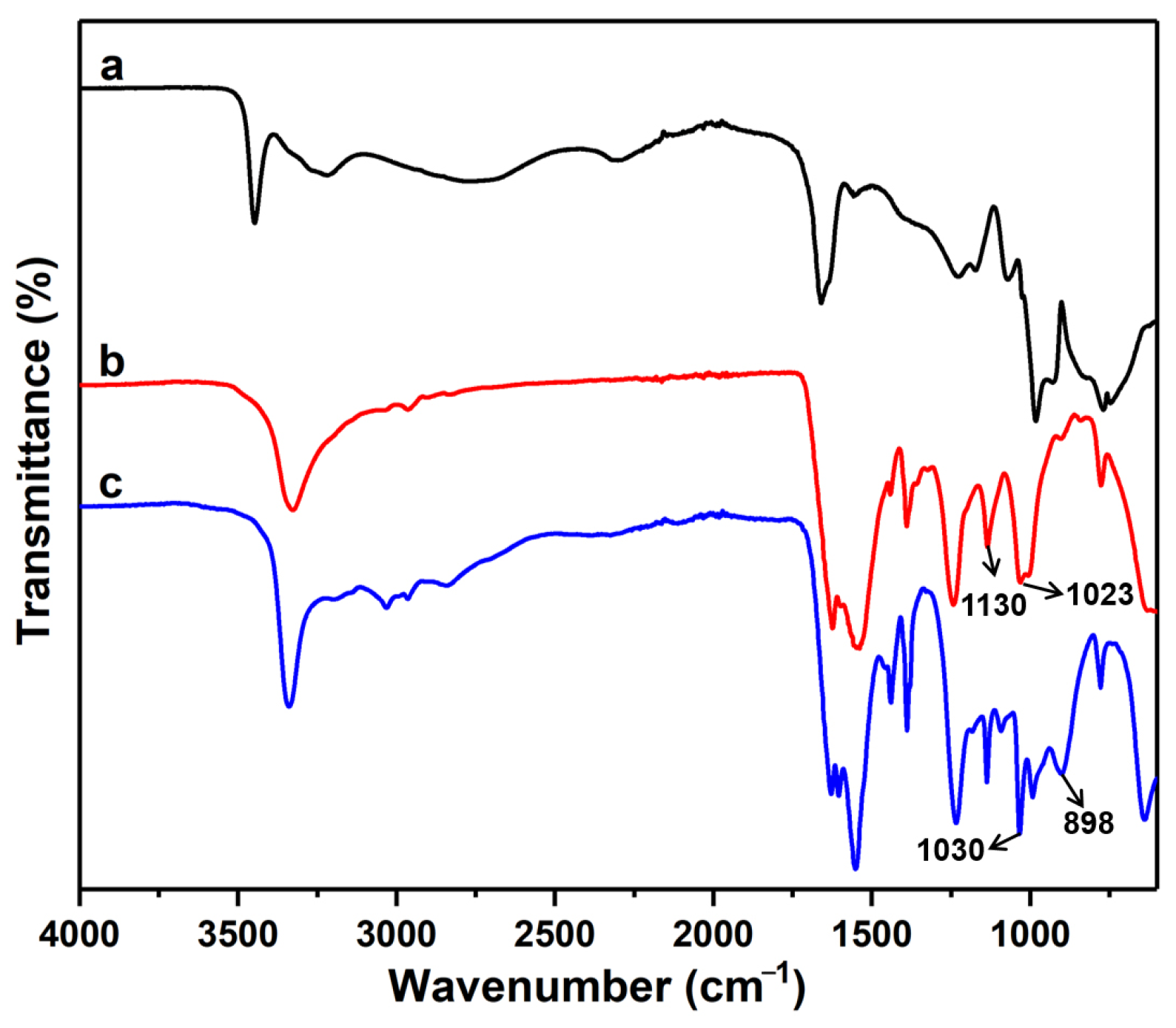
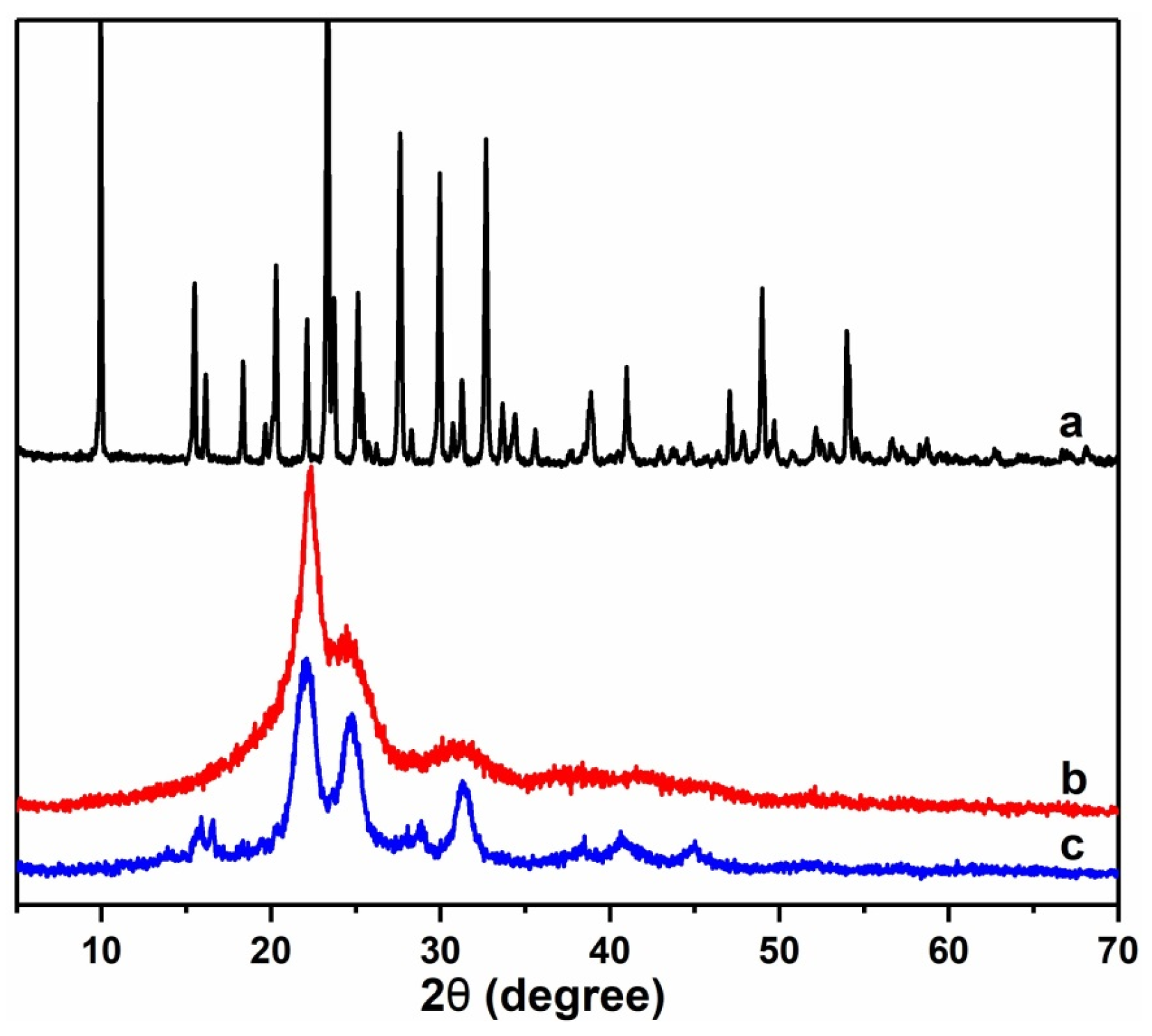

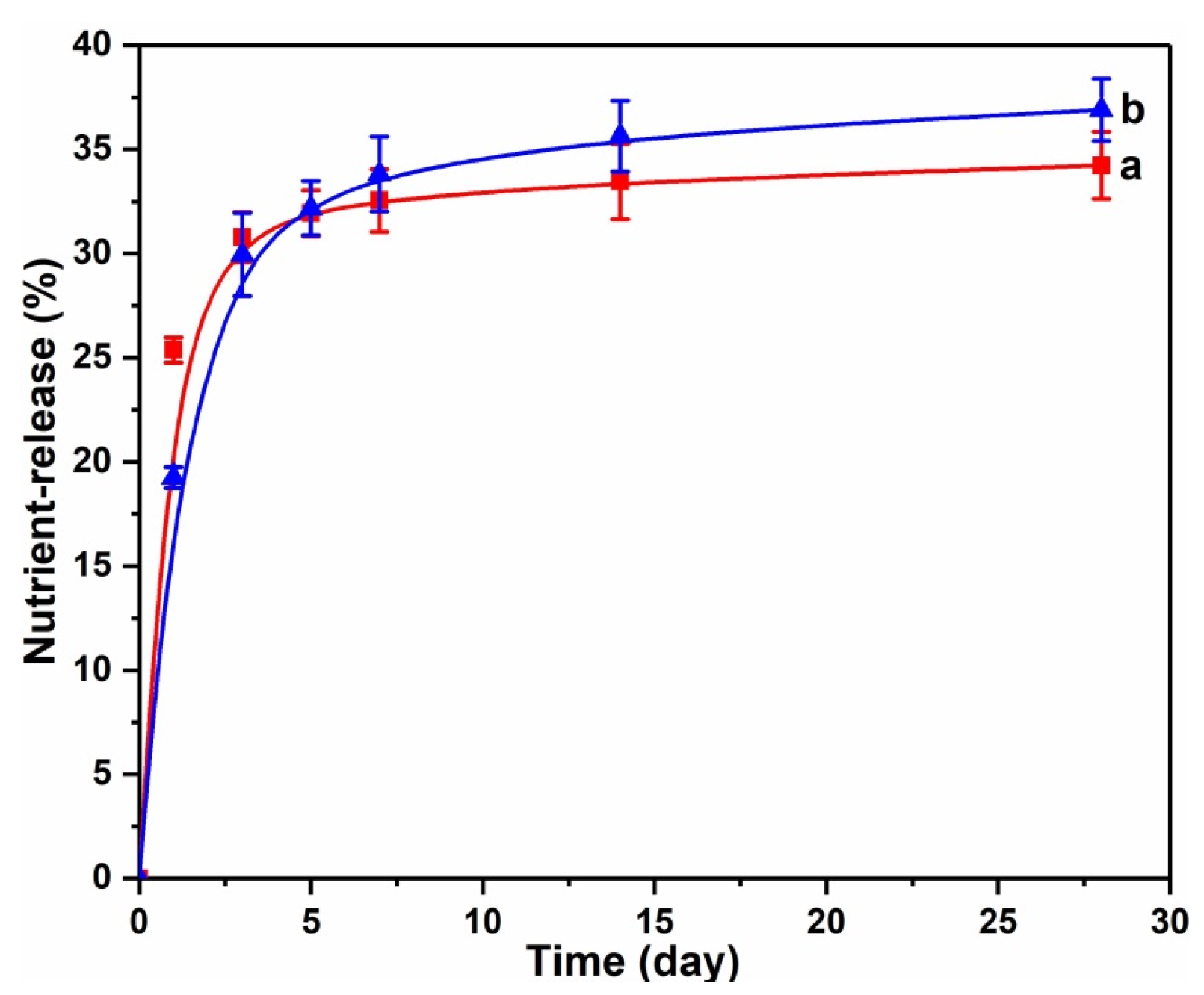
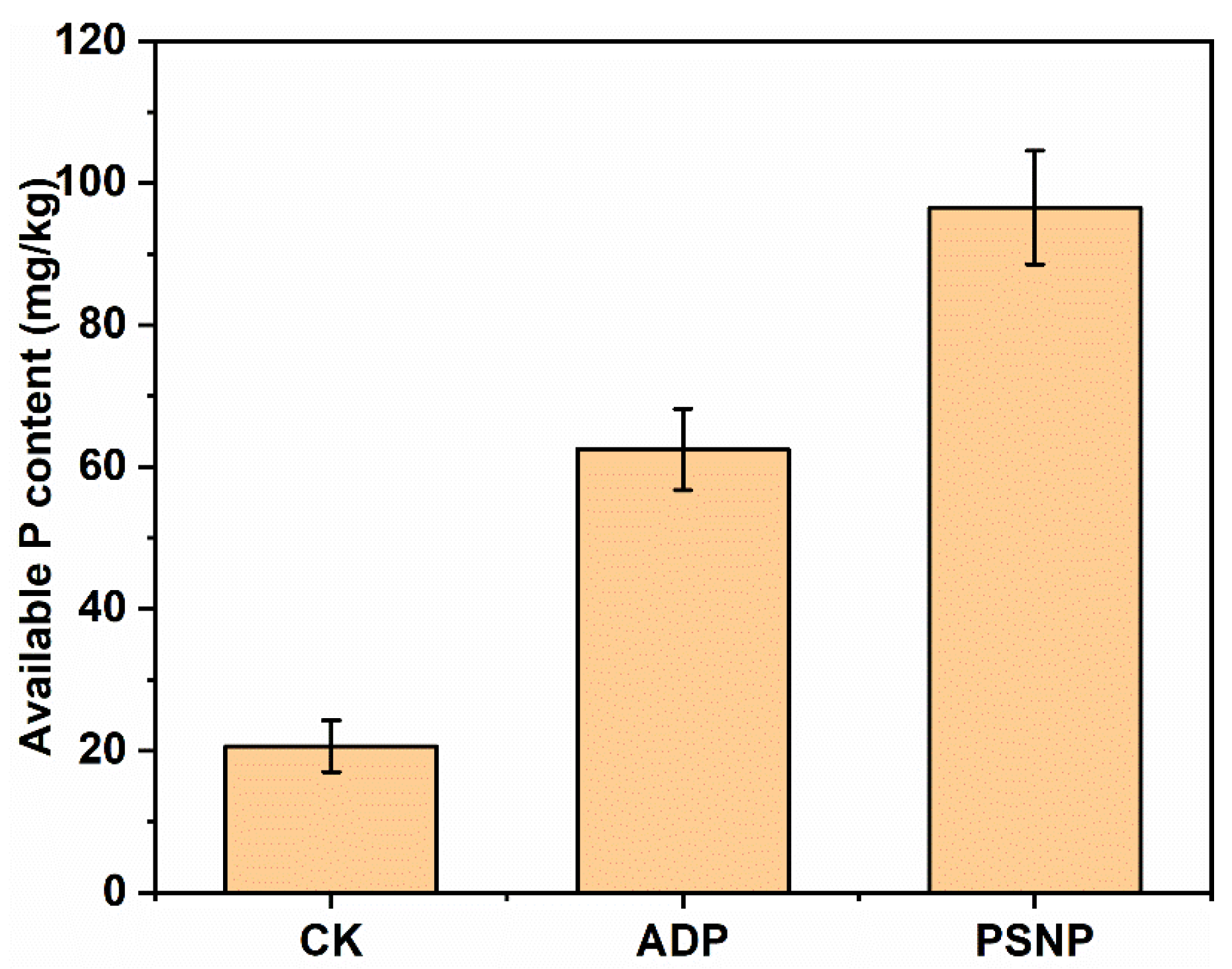


| Characteristics | UF | PSNP |
|---|---|---|
| N content (%) | 29 | 22 |
| P (P2O5) content (%) | \ | 20 |
| Soil Properties | pH (1:2.5, Soil:Water) | Cation Exchange Capacity (cmol/kg) | Organic Matter (g/kg) | Total N (g/kg) | Available P (mg/kg) | Available K (mg/kg) |
|---|---|---|---|---|---|---|
| Value | 7.91 | 15.20 | 18.01 | 0.92 | 24.08 | 55.14 |
Disclaimer/Publisher’s Note: The statements, opinions and data contained in all publications are solely those of the individual author(s) and contributor(s) and not of MDPI and/or the editor(s). MDPI and/or the editor(s) disclaim responsibility for any injury to people or property resulting from any ideas, methods, instructions or products referred to in the content. |
© 2023 by the authors. Licensee MDPI, Basel, Switzerland. This article is an open access article distributed under the terms and conditions of the Creative Commons Attribution (CC BY) license (https://creativecommons.org/licenses/by/4.0/).
Share and Cite
Xiang, Y.; Liu, Y.; Gong, M.; Tong, Y.; Liu, Y.; Zhao, G.; Yang, J. Preparation of Novel Biodegradable Polymer Slow-Release Fertilizers to Improve Nutrient Release Performance and Soil Phosphorus Availability. Polymers 2023, 15, 2242. https://doi.org/10.3390/polym15102242
Xiang Y, Liu Y, Gong M, Tong Y, Liu Y, Zhao G, Yang J. Preparation of Novel Biodegradable Polymer Slow-Release Fertilizers to Improve Nutrient Release Performance and Soil Phosphorus Availability. Polymers. 2023; 15(10):2242. https://doi.org/10.3390/polym15102242
Chicago/Turabian StyleXiang, Yang, Yaqing Liu, Mingshan Gong, Yingfang Tong, Yuhan Liu, Guizhe Zhao, and Jianming Yang. 2023. "Preparation of Novel Biodegradable Polymer Slow-Release Fertilizers to Improve Nutrient Release Performance and Soil Phosphorus Availability" Polymers 15, no. 10: 2242. https://doi.org/10.3390/polym15102242
APA StyleXiang, Y., Liu, Y., Gong, M., Tong, Y., Liu, Y., Zhao, G., & Yang, J. (2023). Preparation of Novel Biodegradable Polymer Slow-Release Fertilizers to Improve Nutrient Release Performance and Soil Phosphorus Availability. Polymers, 15(10), 2242. https://doi.org/10.3390/polym15102242






